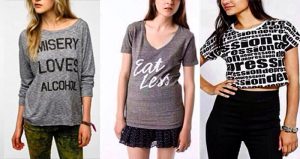Susan Bordo’s (1997) article “Never just Pictures” highlights the correlation between media and body image in women. Bordo describes how, from a shockingly young age, children learn to distinguish desirable body types from others. Fat and overweight body types are shamed and discriminated against. Bordo examines how the fashion industry has influenced society’s perceptions of beauty and the ideal woman’s body. Although this article was published in 1997, models for high-fashion runway shows still appear “waifish” and undernourished in 2017. Eating disorders can arise from a number of causes including social expectations brought upon by media depictions.
I found the mention of the “heroin chic” look to be disturbing. This look romanticizes depression and appearing “zombie-like” or on the verge of death. I’ve seen this trend appear many times in the media in recent years. In my own experience I have seen people sporting clothing that portrays depression and other mental illnesses as trendy and glamorous. Here are a few examples:
PlaidZebra (2014)
This article sparked confusion in me of why we like to romanticize unpleasant ways of being, disorders, and situations. One I often see play out in person and on social media is the stereotype of the “struggling university student”. Why do we glamorize over-exhaustion and over-exerting oneself?
References:
Bordo, S., “Never Just Pictures,” in Twilight Zones: The Hidden Life of Cultural Images
